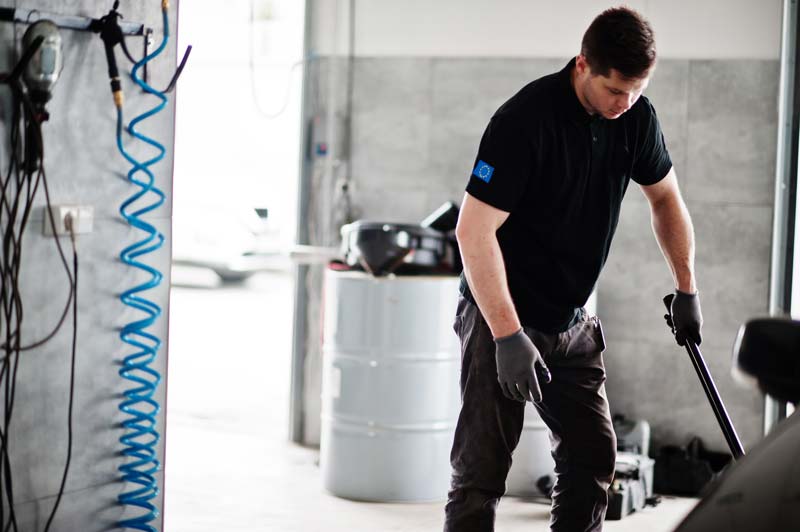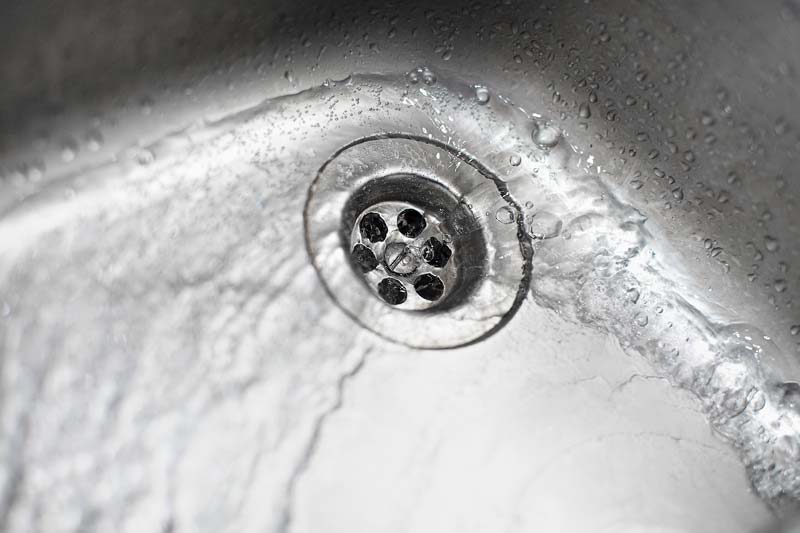
Installing a french drain is an effective way to solve basement water problems. A french drain, also known as a sub-surface drain system, is composed of gravel or another type of rock, piping, and filter fabric that catches moisture from the ground and allows it to flow away from the foundation walls. This can help keep your basement dry and free from problems such as mold, mildew, and musty odors. If mold is already present, professional mold removal services may be necessary to ensure a clean and healthy environment.
What Is A French Drain and How Does It Work?
A French drain is an effective yet simple solution for water drainage problems. Constructed from perforated pipes and gravel, it captures water runoff and diverts it away from residential or commercial properties and areas where drainage problems occur. Anchoring the French drain in a trench helps to keep silt and contaminants from being carried into the pipe, ensuring that the water remains free-flowing.
The use of gravel around the pipe creates a porous media by allowing filtered liquid particles to seep through while preventing soil particles from entering, keeping it clear and unobstructed so that when heavy rainfall occurs, water runoff is guided towards the entrance of its outlet without flowing back into your lawn or other areas at risk for flooding. They are commonly used in basement waterproofing, landscaping, and managing agricultural drainage.
The Benefits of Installing a French Drain
Installing a French drain can be an effective way to protect your home from flooding and water damage. Here are some of the key benefits of this type of drainage system:
- Reduces water pooling: French drains can redirect water away from low-lying areas, preventing water from pooling and causing damage to foundations, walkways, and other structures.
- Protects buildings from water damage: French drains can be installed around foundations to protect buildings from water damage caused by heavy rain or snowmelt.
- Prevents erosion: French drains can prevent erosion by redirecting water away from slopes and embankments, keeping soil in place.
- Basement waterproofing: French drains can prevent water from entering basements and causing leaks or flooding.
- Improves drainage: French drains can improve drainage on your property, allowing water to flow away from structures and into a safe location, where it can be directed away from your property.
- Enhances landscaping: French drains can be used to create a dry stream bed or drain water from a pond, enhancing the appearance of your landscape.
- Cost-effective: French drains are relatively cost-effective and easy to install, requiring only a trench, pipe, and gravel or rock.
How To Prepare For A French Drain Installation
Preparing for a French drain installation is important in ensuring it is effective. Here are some of the things you should do before calling in a professional installer:
Determine the Location of the French Drain
The location of a French drain is one of the most important factors in ensuring that it is effective. To determine its location, it is important to consider factors such as the size and shape of the drainage area, the soil type and slope, the depth of water penetration, and other local terrain features.
Remember that drains are typically installed on sloping land to redirect water away from buildings or low-lying areas, so analyze the land area properly. You can do this by checking the areas where water may infiltrate your home, such as cracks in the foundation or gaps around windows or doors. If you have a pond, a dry stream bed, or other landscaping features that collect water, consider installing a French drain to redirect water away from these areas.
It is also important to ensure that there are no underground pipes or wires that could be damaged by excavation. Once these factors have been considered, hire an expert installer to assess your property and provide recommendations for the best location for the French drain.
Obtain Necessary Permits
Installing a French drain requires certain permits from local authorities. Depending on the area, permits can be needed for excavation, water management, and building codes. It is important to obtain all necessary permits before installing to avoid costly fees or penalties. Additionally, it is important to contact local utility companies before excavating to ensure that no underground utilities are damaged during installation.
Rent or Buy Equipment
If you plan to install the French drain yourself, rent or buy the necessary equipment, such as a trenching machine, pipe, gravel, or rock. Read the instruction manual and follow safety protocols when operating any equipment.
Hire a Professional

If you are not comfortable installing a French drain yourself, consider hiring a professional contractor to do the job. Professional contractors will have the experience, knowledge, and equipment necessary to ensure the installation is done properly. They can also advise you on the best materials and techniques to use and provide information on maintenance and repair.
Have a Plan for the Water
Think about where the water will go after it’s been drained so that you can also plan for that. A dry well is a great option for redirecting water away from your home and can be installed in conjunction with a French drain. Consider where the drainage will end up and ensure that it is directed to a safe location that can be directed away from your property.
How Deep Should a French Drain Be?
The depth of a French drain will depend on the type you are installing. For instance, graveled drains should typically be installed between 12 and 24 inches, while french drains are typically installed between 8 and 12 inches below the surface ground. This depth helps ensure that water can easily flow away from the foundation of buildings or low-lying areas.
How Much Does a French Drain Cost?
The cost of installing a French drain can vary greatly depending on the size and complexity of the job. Factors that affect the cost include the materials used, the labor involved, and other associated costs such as permits or excavation. Generally, an exterior French drain installation will start between $10 and $50 per linear foot, while the interior can range from $40 to $100 per linear foot.
The overall french drain installation cost can range between $500 and $18,000 but may be up to several thousand dollars in more complex or large-scale applications. For a more accurate estimate, it is important to consult a local expert installer.
Can I Install French Drains in My Staten Island, NY, Property?
It is possible to install French drains in Staten Island, NY. However, before doing so, you must obtain the necessary permits from local authorities and contact your local utility companies to ensure no underground cables will be affected. Additionally, certain building codes may need to be adhered to during installation. It is important to consult a qualified and experienced contractor to ensure that all necessary requirements are met and the job is done correctly.
Maintaining Your French Drain in Staten Island, NY
To ensure that your French drain continues to function effectively and safely over time, it is important to regularly inspect it and ensure that it is maintained and kept clean. Here are a few tips on maintaining your French drain in Staten Island, NY.
- Regularly check for clogs and debris build-up in the drain and remove them as needed.
- Use a drain cleaner in Staten Island, NY, specifically designed for French drains to keep the system clear and functioning properly.
- Consider hiring a professional drain cleaner in Staten Island, NY, to perform regular maintenance on the French drain system.
- Ensure that the drain’s surrounding soil and landscaping are properly graded to prevent water pooling near the drain.
- Check for leaks or damage to the drain’s pipes and repair or replace them as necessary.
- Keep an eye on the water level in the catch basin of the French drain and make sure that it is not overflowing.
- To prevent clogs, avoid disposing of grease, oil, and other non-biodegradable materials down the drain.
- If you have trees around the drain, keep the roots trimmed to prevent them from clogging the drain.
How to Clean French Drains
French drain cleaning costs can vary and depend on the blockage’s severity. Depending on your location, drain cleaners in Staten Island, NY, may charge by the hour or a flat fee. If you are attempting to clean your french drain yourself, always wear safety gear such as protective clothing, gloves, and eyewear.
To ensure a successful and long-lasting french drain, you should complete regular maintenance and clean yearly. The easiest way to do this is by filling the pipe with water and running a drain snake through it to remove debris. It’s important to ensure the drain is clear of any build-up before proceeding with further maintenance.
You can also use a shop vacuum or a specialized french drain cleaning solution designed specifically for french drains. For more stubborn clogs, you may need to use chemical solutions such as bleach or baking soda or hire professional drain cleaners in Staten Island, NY, to do the job. Depending on the severity of the clog, you may also have to use a pressure washer or even call in a french drain cleaning service such as Drain Cleaning Pros Staten Island.
The Best Drain Cleaners in Staten Island, NY

There are several companies to choose from if you’re looking for the best drain cleaners in Staten Island, NY. Drain Cleaning Pros Staten Island has a reputation for providing top-notch services at competitive prices and offers comprehensive french drain cleaning services and plumbing repair and maintenance.
Contact them today for more information!
